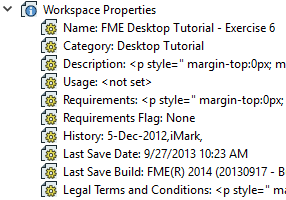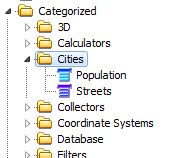Workspace Properties
Workspace Properties contain information that is applicable to the current workspace.
Adding Workspace Properties is optional, but it is a good example of FME Best Practice. It is especially helpful to include this information when you are creating templates.

Note: Similar properties exist for templates, custom transformers, and custom formats. The title of the parameter changes depending on what is open on the canvas. For example, when a custom transformer is open, you will see Transformer Properties instead of Workspace Properties.
All properties are accessible from the Navigator pane. Double-click the property name to edit.
Name
The default title contains information about the Reader and Writer format, the template, or the custom transformer, but this parameter allows you to change it. Enter a more descriptive title, less than 140 characters (for example: CAD-GIS: Converting text to attributes).
Add or edit the text in the Name field. When you click OK, the changes will reflect in the Workbench title bar.
To rename a template, open it, then select File > Save As Template with the new name.
Category
Choose or create a Category. For example, you might want to organize a group of templates in one related category, or group transformers that are used in a particular workspace. If a category contains templates, the category name will appear as a separate folder in the Template Gallery (My Templates):

If a category contains transformers, the category name will appear in the Transformer Gallery:

An item can appear in multiple categories.
Note: You may have to restart Workbench before a new category is visible in the user interface.
Renaming or Deleting Category Names: To rename a category, open the folder in Windows Explorer. By default, this location is C:\Users\<user>\Documents\FME.
Description
This parameter allows you to enter a description. The description is particularly important when you are using the workspace via an FME Server – because it provides a mechanism for a web page to describe what the process is intended to carry out.
Double-click this parameter to display the Edit Workspace Properties dialog. Type the description in the dialog, then click the OK button at the bottom to dismiss the window.
The description you enter will appear in the Description parameter with the proper encodings for spaces, formatting, etc.
Usage
List any special instructions here. Example:

Requirements
List any requirements that must be met before using the workspace or template, such as where the source data resides or minimum FME version required. You should also list any dependencies (for example, if you need a third-party application or an extra-cost transformer).
Requirements Flag
If there are requirements that must be met before using a template, choose one of these options:
- None: This is the default, and indicates that all data is included and the workspace can be downloaded and run immediately.
- Workspace: The template will need some modifications before it can be run.
- Third party: Additional software is required to run this template. The Requirements parameter contains the details.
History
Record changes made to the workspace. This is especially good practice if you are sharing data or workspaces.
Example:

Last Save Date and Build
These automatically generated parameters display the save history for the workspace.
Legal Terms and Conditions
Use this area to record any legal information (for example, copyrights or data restrictions).
Viewing and Editing
To view workspace properties, click View > Windows > Workspace Properties. This dialog is modal, so you can keep working without having to dismiss it.
Note: This menu selection changes for templates, custom transformers, and custom formats. For example, when a custom transformer is open, you will see View > Windows > Transformer Properties.
To edit workspace properties, double click any parameter in the Navigator.